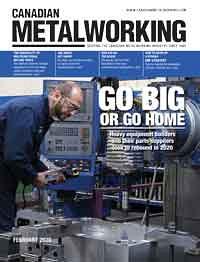Founder/President
- FMA
- The Fabricator
- FABTECH
- Canadian Metalworking
Blockchain comes to manufacturing
Blockchain will form the foundation of the next manufacturing renaissance
- By James Allen Regenor
- March 5, 2020
- Article
- Automation and Software

Blockchain-based technology allows capturing data and verifying each transaction digitally along every step of the manufacturing process.
Amid predictions of global economic slowdowns and recent PMI readings indicating manufacturing contraction, it becomes easy to see how slow production performance and data inefficiencies throughout the manufacturing supply chain contribute to economic uncertainty and concerns for future business.
At the same time, manufacturing’s history is replete with numerous great leaps forward in technology and technology application, each of which was followed by enormous business opportunities and economic expansion for the agile and articulate.
Blockchain creates trust
The application of blockchain, the distributed ledger system behind Bitcoin, is demonstrating great promise for being a breakthrough of historic proportions for the entire manufacturing supply chain in many critical industries.
In his book Sapiens: A Brief History of Humankind, Yuval Noah Harari noted, “For the first time in the 50,000 years of modern human history, we now have the opportunity to establish peer-to-peer trust.” Trust is a powerful enabler in business because it fundamentally anchors relationships.
Blockchain allows individuals and companies to build trust in their business relationships and transactions.
Industries with critical part-performance requirements, including aerospace, defence, energy, automotive, and medical, are well-acquainted with trust relationships, having part-checking requirements and verifications built into their supply chains.
What they’re not acquainted with is top supply chain efficiency.
Manufacturers spend millions verifying part and process quality with varying degrees of success, from antiquated and time-consuming job tickets and paper trails to complex, Big Data-inspired computerized systems requiring extensive, customized, and costly IT infrastructures. Manufacturing companies without the knowledge or resources are effectively cut out from acquiring or growing any business in complex-part manufacturing.
Every action in the supply chain – obtaining raw materials, confirming and finalizing part design adjustments, manufacturing, post-processing, shipping – generates microbursts of data, energy, and bandwidth. Blockchain-based technology allows capturing this data and verifying each transaction digitally along every step of the process. Essentially, this creates an append-only digital ledger system, available any time, to any participant, whenever needed.
Blockchain offers a way for people who do not know or trust each other to create a record of who owns what and preserves truths.

Reduced lead times coupled with the ability to push a part to the point of need via the cloud and 3D printing is transformative for supply chains, whether it is on an aircraft carrier, the space station, or at a Formula 1 race.
In a manufacturing world of digital part designs with files that not only establish design provenance but also power CNC machining and 3D printing equipment, establishing and preserving truth along each step of design, manufacturing, and customer handoff is an essential commodity.
The blockchain becomes this trusted third party. It provides proof of who owns what at any given juncture.
Adjusting blockchain to part production and verification essentially and efficiently digitizes the paper trail for design through manufacturing and logistics. Now that digital asset created with the digital part design and blockchain pedigree can be “transported” anywhere in the world through the cloud via a digital network.
Now manufacturing is pushed to the edge and companies can transform that digital part into a physical part at the time of consumption when needed. Hundreds of distributed process participants – designers, engineers, raw material buyers, equipment operators, process specialists, assemblers, schedulers, shippers, and all the supervisors in between – can be generating and appending thousands of ledger pages across ad-hoc networks that effectively establish peer-to-peer trust as parts move through production.
Such a process also becomes self-policing, quickly identifying underperformers and thereby strengthening the supply chain. Design and manufacturing owners retain their ownership and can aggregate and reward intellectual property from all stakeholders. Part and process provenance, meaning to establish the true origin or source, is determined every step of the way.
Establishing use
Bloomberg said recently that 86 per cent of U.S. industry has either finished or has an ongoing blockchain project. What are the challenges? It pays to remember that technology does not solve any problems – zero. It is the application of technology that solves every problem.
That said, blockchain challenges in the manufacturing supply chain cover both technical and business-related hurdles.
On the technical side, there is interoperability and scale. The business challenges are value creation and behaviour modification.
Value creation, or tying technology application to a problem solution, is where we earn our keep. Blockchain will allow for the creation of new value and new business models as it is applied to solve industry challenges. Behaviour modification naturally follows as our suppliers move into the “trust” ecosystem. A company’s ability to modify the behaviour of supply chain participants depends on its position in the value chain.
The best example recently is Walmart telling its lettuce suppliers they now must be on Walmart’s blockchain. Suppliers either comply or sell elsewhere. Walmart and others are hopeful blockchain can increase food safety. In contrast, if the lettuce fertilizer company said get on my blockchain or I won’t sell you fertilizer, farmers are free to buy fertilizer somewhere else.
Enter 3D printing
In 2015 the company I worked for, Moog Inc., acquired a 3D printing service bureau, and being in business development, I was involved with examining what value 3D printing brought to our businesses and customers.
We were supplying support to the military depots tasked with supporting legacy fleets for the U.S. Air Force, like the Boeing KC-135 Stratotanker military refueling aircraft. As an Air Force pilot, I flew the KC-135. Most of these were built in the late 1950s and early 1960s and as such suffered obsolescence problems and diminishing sources of replacement components. This proved a great use case for 3D printing.
Consider this scenario. You’re on an aircraft carrier in the middle of the Indian Ocean with the deck pitching and rolling. You have an F-18 that’s just received a critical mission. Lives are at stake. Your plane has to fly and it needs a part.
Even if you have a 3D printer onboard, how do you know, No. 1, that your design data for the part is secure, that it has not been tampered with by an adversary, and, No. 2, that your processes, material, and build conditions are such as to produce a good performance part?
Standing on the carrier deck, I quickly distilled the challenge was how do you put “trust” in this process. We became aware of blockchain and started asking questions. Can we provide data integrity with blockchain? Can we provide transparency, traceability, and process integrity? How much data and information are required to manufacture trust?
We began to build out models of what solutions might look like, starting with asking ourselves, “What does blockchain really enable, and what is the telos, or end state?”
Through many months of ideation, we established we could create a distributed manufacturing network – a distributed network of 3D printers and the capabilities to deliver a finished part verified to industry and regulatory standards.
We could now push trust outside the four walls of the factory to a distributed network and not be overwhelmed with transaction costs. Another thing we realized was the value of this process wasn’t simply monetary. Value creation in this case was the ability to access remote locations and to get these parts out securely and quickly. Utilizing this new modality of logistics, we realized we could actually reduce non-value-added costs that burdened traditional supply chains like packaging, transporting, warehousing, and managing physical inventories. We also saw value creation in that now companies could order a lot size of one and not be burdened with a minimum-quantity order or be forced to buy a kit to get one part.
This also drove down part lead times substantially. In our proofs of concept for the U.S. DOD, we reduced part lead time on an F-15 part from 265 days to a matter of hours, and on another F-15 part from 133 days to hours. Reduced lead times coupled with the ability to push a part to the point of need is transformative for supply chains, whether it is on an aircraft carrier, the space station, or at a Formula 1 race.
Quality control
Another effect that blockchain enables is rapid forensics. Let’s say there’s a malfunction on an aircraft. Doing a root-cause analysis can take months. With a distributed manufacturing network where each decision -- from material specifications and purchase through production, post-processing, and shipping -- is documented, verified, and recorded in a digital manner versus the paper records of today, reverse forensics are accomplished very quickly.
Convergence
The convergence of blockchain, 3D printing, and Industry 4.0 principles is now an emerging reality. We recently debuted VeriTX, an on-demand digital marketplace for suppliers and customers of aerospace components, later expanding to medical and industrial markets. VeriTX leverages blockchain technologies to create a digital twin of parts as they are tracked through their life cycle. Now data can be collected and aggregated across part families and fleets as VeriTX provides verification and trust. Design integrity, material integrity, and process integrity are assured, rapid forensics are available in the event of an incident, long lead times and non-value-added costs are greatly reduced, smart contracts provide immediate settlement, and counterfeit parts are pushed out of the supply chain.
Not only can you push that part to where it’s needed in seconds, there is a distributed, transparent ledger proving design, material, process, and part integrity while protecting intellectual property every step of the way. This reshapes and significantly improves the manufacturing supply chain. This changes the world.
James Allen Regenor is co-founder of Blockchain Resources Group, Charleston, S.C., and founder and president of VeriTX, 174 Main St., Suite 130, East Aurora, N.Y. 14052, 716-239-6109, www.veritx.co.
About the Author
subscribe now


Keep up to date with the latest news, events, and technology for all things metal from our pair of monthly magazines written specifically for Canadian manufacturers!
Start Your Free Subscription- Industry Events
MME Winnipeg
- April 30, 2024
- Winnipeg, ON Canada
CTMA Economic Uncertainty: Helping You Navigate Windsor Seminar
- April 30, 2024
- Windsor, ON Canada
CTMA Economic Uncertainty: Helping You Navigate Kitchener Seminar
- May 2, 2024
- Kitchener, ON Canada
Automate 2024
- May 6 - 9, 2024
- Chicago, IL
ANCA Open House
- May 7 - 8, 2024
- Wixom, MI




















